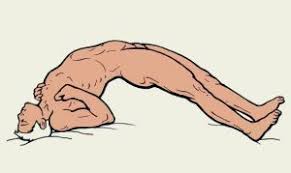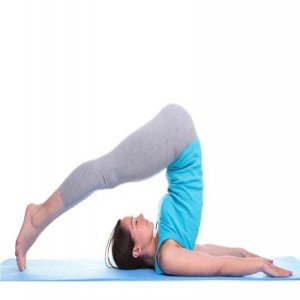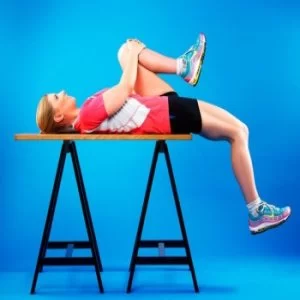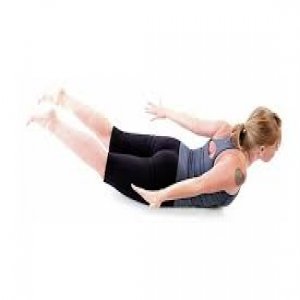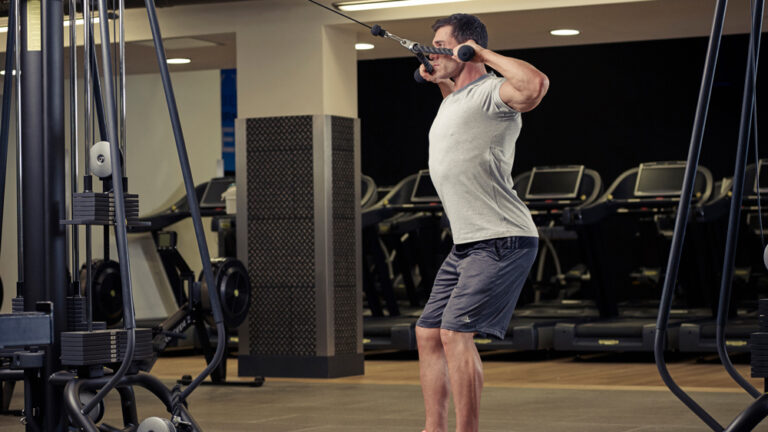Best Exercise To Gain Shoulder Mass
To build shoulder mass, you’ll want to focus on compound exercises that hit all three heads of the deltoid muscle: the anterior (front), medial (side), and posterior (rear). There are a few factors to consider when targeting your shoulders in your workouts, particularly if your goal is to gain muscle mass. First, take good care of your joints and pay attention to any problems such as tight muscles, that may be preventing you from moving your shoulders freely.
According to a study you put stress on your joints and assisting muscles when you have limitations in your range of motion.” “Usually, that results in injuries or pain.” A study suggests stretching and foam rolling the tissues preventing you from working out as a treatment.
Secondly, don’t be afraid of trying longer workouts. Because of their complexity, shoulders need a lot of mobility to develop. Volume and intensity are the two main characteristics of hypertrophy, or muscular growth, according to the study. If you want to bulk up, you may want to add a few additional sets to your program to help shock your shoulders into expansion.
Introduction
It’s not that exercise is all about making gains. Three weeks of daily shoulder exercises significantly reduced pain and improved function in patients with rotator cuff-related shoulder pain, according to a study published in the International Journal of Sports Physical Therapy.
We approached PT and also our fitness trainer for some of their greatest shoulder exercises, which we then fashioned into an aggressive shoulder workout that grows muscle quickly, for your health’s benefit and to give you the best pump up top. The good news is that your shoulders will grow stronger faster than any other part of your body if you’ve never really challenged them.
What Are the Muscles in the Shoulder Called?
All right, so without knowing which muscles comprise your shoulders, we cannot begin to strengthen them. The muscles that comprise the shoulder are classified as extrinsic muscles, which come from the torso and attach to the shoulder bones, and intrinsic muscles, which come from the scapula, clavicle, or both and attach to the humerus.
The Shoulder’s Extrinsic Muscles
Trapezius
The triangle-shaped muscle that crosses your shoulder blade and runs down your spine is called your trapezius. Your arms can only be raised by using your left and right trapezius muscles, which support your shoulders and arms.
Latissimus Dorsi
One of the biggest muscles in your back, the latissimus dorsi is partially covered by the trapezius muscle. You’ll find that controlling your body weight is easier if you work on your “lats.”
Levator Scapulae
Your levator scapulae muscle is located on the side and rear of your neck. Its primary function is to elevate the scapula, a triangle-shaped bone at the rear of the shoulder that joins the humerus (the upper arm bone) to the clavicle (the collarbone).
Rhomboids
The muscles in the middle of the shoulder blades and at the top of the back are called rhomboids. When your shoulder blades contract, they bring them together.
The Shoulder’s Intrinsic Muscles
Deltoids
The anterior, lateral, and posterior muscle groups that comprise your deltoid are joined by a thick tendon and are anchored into a V-shape. Although its primary function is arm rotation, the deltoid muscle also prevents humeral dislocation and damage when lifting large objects.
Teres Major
On the inside of the upper arm lies a tiny muscle called the teres major. Because of its relationship with the latissimus dorsi, it is frequently referred to as “Lat’s little helper.”
Rotator Cuff
The rotator cuff is a collection of tendons and muscles that support the shoulder joint, including the teres minor. They maintain the highest point of your upper arm bone firmly in the shoulder’s shallow socket.
Is it a good idea to train shoulders every day?
There are numerous factors to consider when deciding on training frequency. As an example, how your body responds, heals, and rebuilds depends on a variety of factors, including age, food, recovery schedule, and exercise intensity. However, it can be attractive for many people expecting fast results to train in the same body region daily. However, it’s hardly the ideal fix. Putting your body through such constant stress might result in disease and harm.
The amount of work you complete in a given week, month, or longer matters significantly more than the amount you complete in a single session. Therefore, it’s generally a bad idea to repeat a shoulder exercise that you presently do once a week three or four times a week. Rather, consider ways to ramp up your workload so that you’re still producing more, and then consider ways to distribute that work throughout the week. In this manner, you’ll probably shock your shoulders into growth and be able to exert greater force into each action.
How much time is needed to develop larger shoulders?
Muscle growth is primarily dependent on one’s ability to recover from exertion rather than a simple volume of effort. Thus, simply increasing your workload won’t guarantee that you gain more and more muscle; instead, you must give yourself enough time to recover between workouts to avoid preventing muscle growth. As a result, you can target certain muscles, like the front, side, or rear delts, on their respective days, giving them enough time to recover while you work other areas. Fortunately, the deltoids are divided into separate sessions that are very straightforward to isolate.
A person’s genetics, diet, and training age all affect how long it takes for their shoulders to grow. In case you haven’t noticed any growth in your deltoid muscles and you choose to give your shoulders more attention by increasing their volume, and frequency, and gradually overloading them with four to six essential exercises, you should anticipate some growth in the next four to six weeks. Just be careful to eat enough calories to power your training sessions and enough protein to aid in recovery (1.5-2g per KG of body weight).
A good shoulder exercise plan follows these three guidelines:
Lift heavy and focus on strength gains
Many players make their preparations too complicated. Performing heavy lifting on the most crucial exercises and concentrating on achieving small, gradual gains during each workout is one of the greatest, if not the most, tried-and-true methods.
Track Your Workouts
This involves maintaining meticulous records of your workouts and concentrating on becoming better each time. Progressive overload principles must be emphasized because the shoulders are a resistant muscular group, particularly for those who are naturally thin.
Dumbbell Shoulder Press
An excellent exercise for growing shoulder bulk that is utilized by athletes of all skill levels is the dumbbell shoulder press. Push yourself to complete 8 repetitions with the same weight the next day, or go up to 60 lbs and complete 7 repeats if you completed the dumbbell shoulder press with 55 lbs for 7 reps during your last workout. The muscles must react to this basic idea to get larger and more powerful. As elementary as this may seem, far too many gym-goers fail to adhere to this straightforward yet powerful idea. The tiny details add up to a big impact.
Train the deltoid muscles’ three heads.
In brief, deltoids are divided into three divisions. You hardly ever see a shoulder with its front, middle, and back fully formed, which is regrettably a common misconception.
The formation of those imposing-looking stones is almost impossible without sufficient development in all three regions. The V-taper is what separates the normal guy—who is quite lean and muscular with some definition in his abs—from the shredded fitness model, and for many people, building their anterior and posterior deltoid muscles is the final piece in the puzzle to get that desired shape. Your V-taper ratio will be better if your shoulders are thicker and wider.
Mix up your exercise, rep ranges, and rest times
You can get significant increases by varying your workout program, just like you would with any muscle group. For the greatest shoulder workouts that can maximize your muscle development, always strive to switch up your regimen.
Consider the following three guidelines when organizing your exercise schedule:
- Change up the workouts that focus on different shoulder areas. Aim for four to five well-rounded workouts that target the lateral, posterior, and anterior deltoid, and switch them up periodically.
- Don’t forget to change up your range of repetitions. This involves performing high rep sets on some days and heavy sets with the maximum amount of overload on your delts on other days.
- Adjust how long you rest in between sets. Combining hard sets with little rest periods is one of the finest strategies to promote growth.
Here we describe different types of exercise to gain shoulder mass:
Overhead Press
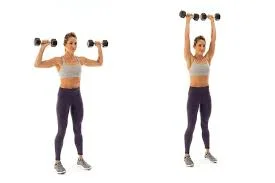
You must perform this exercise while standing tall, your feet shoulder-width apart, and your palms facing each other while holding two heavy dumbbells at shoulder height. Press the dumbbells upward gradually while keeping your elbows in until your arms are straight. Return your hands to your shoulders and do it again.
Standing Lateral Raise
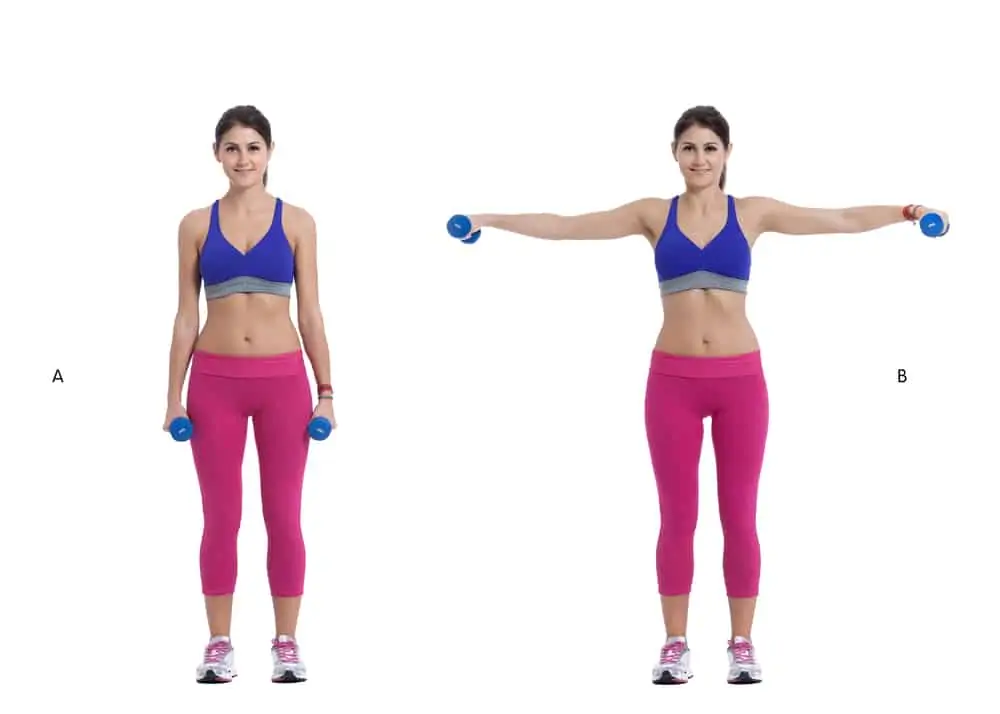
Directly strengthens and develops your deltoid’s side portion.
With your feet hip-width apart, assume a tall stance while grasping two medium-to-light weights at your sides, with your hands facing you.
Raise your arms straight out to the sides, palms down, until they are parallel to the floor while maintaining a tiny bend in your arms.
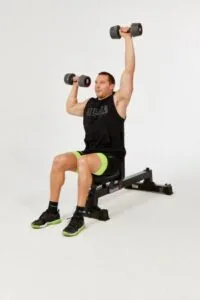
Stop, turn the motion back slowly, and then repeat.
Alternating Shoulder Press
With your feet shoulder-width apart, take a tall posture and stagger your steps by stepping one foot forward slightly. With your hands facing front, hold two medium-to-heavy dumbbells at shoulder height. Completely press the weight above with your right hand. Reverse the motion with the weight down to your left. Keep switching sides.
Monkey Pump
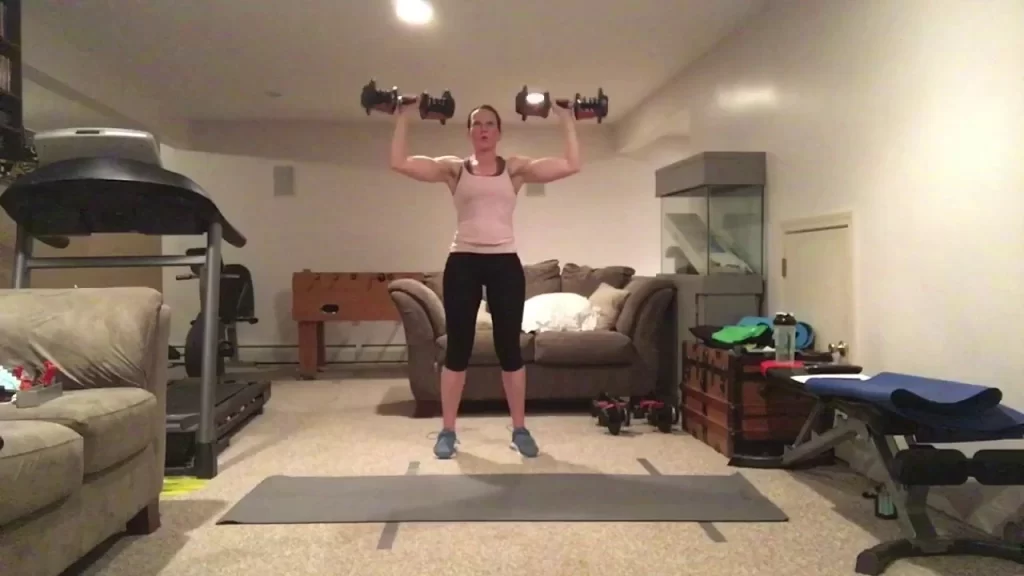
Take two light dumbbells and stand tall in a spread stance. With your elbows bent at a 90-degree angle and your palms facing the floor, hold the weights raised so your upper arms and shoulders are parallel. This is the initial position. Rotate your forearms upward to create a goalpost stance without lowering your upper arms. As near to each other as you can bring your forearms and elbows in front of you. Go back to the location of the goal post. Lift the dumbbells above your head. Go back to where the goalpost was, then start again at that location.
Band Military Press
Grasp the handles of a resistance band and stand shoulder-width apart, placing both feet on the band’s center to stabilize it. Raise your hands, palms forward, to the side of your shoulders. Raise the handles until your arms are in a straight position. Return to your shoulders with your hands lowered, then repeat. With just one foot on the band, attempt the motion while lunging.
Reverse Fly on Bench
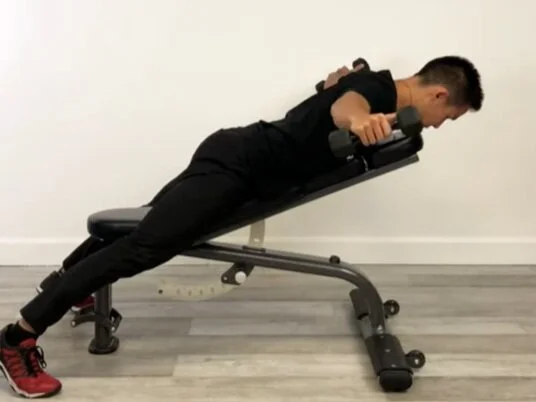
Grasp two lightweight dumbbells while seated on an exercise bench. With your back flat, bend forward to a 45-degree angle, letting the weights drop to the outside of your feet with your hands pointing inward.
During the exercise, squeeze your mid-back and rear deltoids while slowly raising the dumbbells out to the sides while maintaining a straight torso. Repeat the motion in a slow, reversed manner.
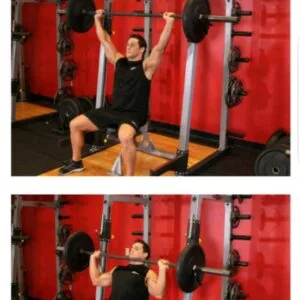
Seated Military Press
Sit on an inclined bench with your back vertically adjusted. Place two heavy dumbbells at shoulder height with your palms facing forward. You should gradually raise the dumbbells until your arms are straight. Return your hands to your shoulders and do it again.
Deep Swimmer’s Press
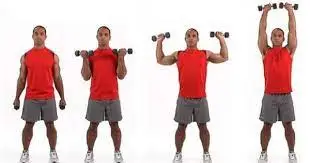
Hold two medium-weight dumbbells while standing erect and keeping your feet hip-width apart. Straighten your arms at your sides and place your palms in front. Curl the weights up to a 90-degree angle while keeping your elbows close to your sides.
Here is where you are supposed to start. As you approach the peak of the exercise, rotate your hands so that your palms are facing forward and curl the weights up towards your shoulders in a single, fluid motion. Repeat the movement, lowering the weights under control and ending with your palms facing your body in a half-curl with your palms up and your eyes fixed on you. Repeat.
Anterior Deltoid Raise
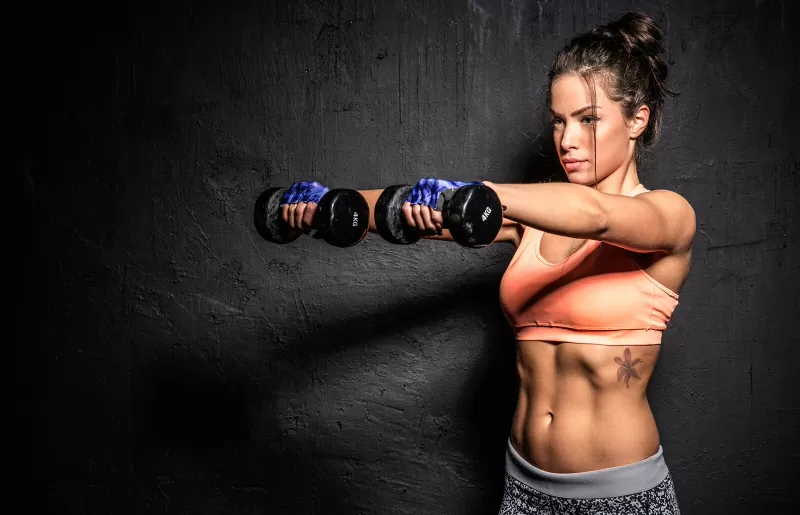
Hold a dumbbell in each hand and keep your arms by your sides while you stand with your feet hip-width apart. Raise the weights straight in front of you to shoulder height, keeping your arms straight and your palms facing each other. Go back to the initial position and do it again.
Callahan Press
Maintain a hip-width distance between your feet while grasping a dumbbell in each hand. With your elbows bent 90 degrees, extend your arms out to your sides. Your hands should be pointing up at the ceiling, and your upper arms should be parallel to your shoulders. This is where everything begins.
Put your forearms in front of you and face your face with your palms facing up. To get back to where you were initially, reverse the motion. To get back to the starting position, press the weights right above your shoulders and then reverse the motion. That amounts to one rep.
Post Delt Fly
Grasp the handles of a resistance band and stand shoulder-width apart, placing both feet on the band’s center to stabilize it. Switch handles with your other hand so that the bands meet. When your body is nearly parallel to the floor and your back is flat, bend your knees slightly and fold forward. (If you need to increase the tension on the band, stretch your feet further.) With the backs of your hands towards the ceiling, raise the handles as far out to your sides as you can while maintaining a motionless torso. Completely lower the handles, then do so again.
Seated Two-Angle Shoulder Fly
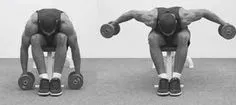
Maintain an upright posture while gripping a pair of dumbbells at your sides at arm’s length. Raise the dumbbells out to your sides until your arms are parallel to the floor, keeping your elbows slightly bent and your palms facing downward. When your body is at a 45-degree angle with the floor, hinge forward and lower them back to the starting position.
Squeeze your shoulder blades together as you raise the dumbbells out to your sides, stopping when your arms are parallel to the floor while maintaining a flat back, a slightly bent elbow, and a braced core. Reduce the weight and take a step back to the beginning. With every repetition, keep switching between the high and low positions.
Face Pulls
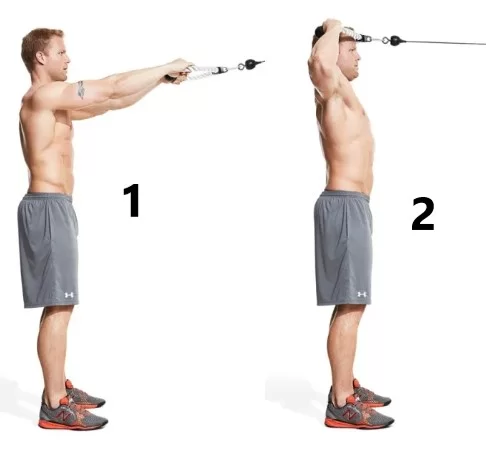
With your thumbs pointed in your direction, hold the rope while positioning the cable just above your head. Toes pointed straight ahead, feet slightly staggered, stand tall. Sketch your abdominals.
With your elbows bent out to the side and your shoulder blades squeezed together, try to force your fists by your ears as you pull the cable toward your face. Return to the beginning position by reversing the pattern. Repeat. Sustain your posture the entire time.
Steer clear of putting your chin forward, arching your lower back, exposing your ribs, and shrugging your shoulders. Using a cable machine or resistance bands is an additional excellent rear delt exercise. 3–4 sets of 15–20 repetitions should be your goal.
Push-ups
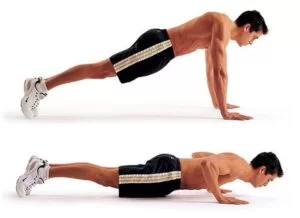
Placing your hands slightly wider than your shoulders, you will begin a push-up on the floor on all fours. Avoid locking your elbows out; instead, keep them slightly bent. Stretch your legs back until your feet are hip-width apart and you are balanced on your hands and toes.
This is how you perform a push-up once you’re in this position. Pull your belly button in the direction of your spine to tighten your core and contract your abdominal muscles. Inhale as you lower yourself to the floor and slowly bend your elbows until they are at a 90-degree angle. Exhale, tightening your chest muscles and raising yourself back up using your hands to take the starting position. Complete as many reps in three to four sets.
How To Prevent Injuries When Doing Shoulder Exercises:
Although shoulder training is advised, it’s important to keep in mind that the shoulder joint is widely prone to injury, so you need to be cautious not to overdo it.
You should mobilize your shoulder joints before beginning any shoulder workout. Spend five to ten minutes extending your range of motion and engaging your shoulder muscles before you touch a weight (we prefer to do plank twists with a reach-through for this).
Next, you should perform some high-rep sets of the first exercise with extremely small weights, or even no weights at all, as soon as your workout begins. By doing this, you will acclimatize the shoulder to the next movements and avoid starting your first set unprepared. You must control the weight you lift once you start your workout.
Choose a lighter choice or reduce the weight if you begin to struggle. For certain muscles, going hard or going home may be effective, but it’s not worth it when it comes to shoulder exercises. Do not be the hero.
Mistakes to Avoid in Shoulder Exercises
As we’ve shown so far, perfecting a shoulder workout involves much more than just consistently pushing weight above. To get the most out of your upcoming shoulder exercise.
Neglecting Your Shoulder Mobility
one examination you should perform is to lie flat on the floor with your legs bent. Then, raise your hands above your head and lower them so that they overstretch and contact the floor. You might not be able to indicate that pushing upwards is safe if you are unable to touch the ground without arching your back. You can be lacking flexibility in your lats or rib cage.
Control the Movement, Both Ways
Making sure we’re managing it throughout the eccentric (falling) phase is important if your objective is to gain strength or muscle when pressing overhead. You are essentially doing half the rep if you are just blasting the weight up or swinging the weight up without controlling it back down.” You can add even more muscle and strength during that eccentric phase.
Treat Your Shoulders Fairly
Your front belts receive a lot of attention; don’t focus solely on them. Your front deltoids are highly engaged and worked hard during bench press and overhead press exercises. You don’t need to perform extra accessory work unless you’re a competitive bodybuilder trying to hit that next one percent. For the sake of posture and shoulder health, make sure your “pulling” and “pushing” motions are balanced. Aim for the back delt flyes.
FAQ
How do you develop broad shoulders?
For functional benefits, it is vital to work on several planes, with different exercises, and with variation; however, this will make it more difficult to gain mass. Exercises for bulking up typically include lateral raises, upright rows, inclined chest presses, supine lateral raises, and shoulder presses (also known as military presses).
Are three exercises sufficient for the shoulders?
Three full-body workouts a week is a decent baseline to start with because it’s important to give your body at least one day to recover between each session. For each of the following muscle groups: back, chest, shoulders, legs, and core, select one exercise from these routines, and as a beginner, try to complete three sets of ten to twelve reps.
How frequently do you work out at the gym?
The number of activities you perform in a gym setting each day will depend on your goals and level of fitness. While it’s generally a good idea to aim for three to four activities per session, two exercises are a fantastic place to start for people who are new to fitness.
What factors affect the size of the shoulders?
Variations in body type, weight, heredity, and other variables can all affect how wide your shoulders are. We offer metrics and techniques for measuring the width of your shoulders created by anthropometry researchers.
Can I naturally grow large shoulders?
While some men have narrower bone structures than others, anyone can get larger shoulders by following appropriate shoulder exercises, engaging in weightlifting to increase muscle mass, and maintaining a healthy bulking diet.
References
- Davies, D., Hicks, R., & Tracey, A. (2023, November 27). The 37 best shoulder Exercises and Workouts for packing on muscle. Men’s Health. https://www.menshealth.com/uk/workouts/g754592/7-best-exercises-for-bigger-shoulders-fast/
- Bodybuilding.com. (2021, May 13). 10 best shoulder workout exercises for building muscle. https://www.bodybuilding.com/content/10-best-muscle-building-shoulder-exercises.html
- Gcfp, A. H. C. (2023, May 1). 12 of the Best Shoulder Exercises to Build Mass. BODi. https://www.beachbodyondemand.com/blog/best-shoulder-workout-mass
- Jacked Factory. (2017, June 1). Boulder shoulders: The best shoulder workout. https://www.jackedfactory.com/blogs/blog/boulder-shoulders-the-best-shoulder-workout


